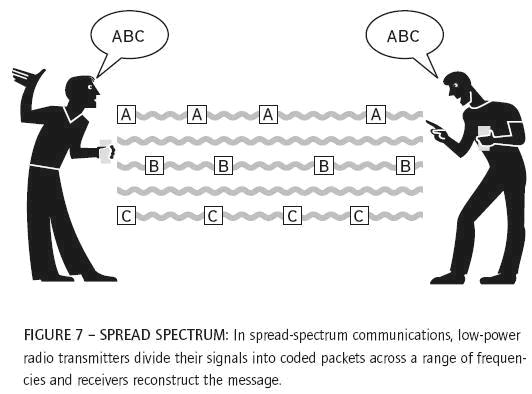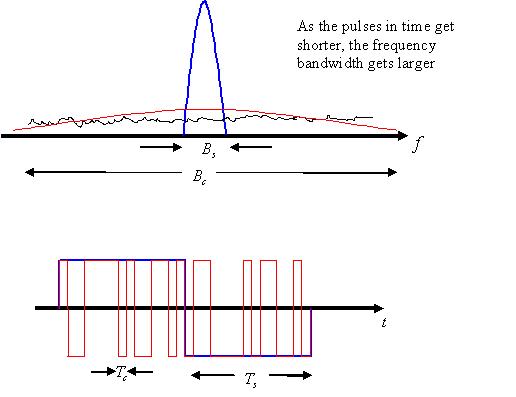Code division multiple access (CDMA) is a channel access method which refers to any of several protocols used in
second-generation (2G) and third-generation (3G) wireless communications. As the term
implies, CDMA is a form of multiplexing,
which allows numerous signals to occupy a single transmission channel, optimizing the use of
available bandwidth. The
technology is used in ultra-high-frequency (UHF) cellular telephone systems in the 800-MHz and 1.9-GHz bands.
CDMA employs analog-to-digital conversion (ADC) in combination
with spread spectrum technology. Audio input is first
digitized into binary elements. The frequency of the transmitted signal is then
made to vary according to a defined pattern (code), so it can be intercepted
only by a receiver whose frequency response is programmed with the same code,
so it follows exactly along with the transmitter frequency. There are trillions
of possible a frequency-sequencing code, which enhances privacy and makes
cloning difficult.
The CDMA channel is nominally 1.23 MHz wide. CDMA networks use a
scheme called soft handoff, which
minimizes signal breakup as a handset passes from one cell to another. The
combination of digital and spread-spectrum modes supports several times as many
signals per unit bandwidth as analog modes. CDMA is compatible with other
cellular technologies; this allows for nationwide roaming.
An analogy to the problem of multiple access is a room (channel)
in which people wish to talk to each other simultaneously. To avoid confusion,
people could take turns speaking (time division), speak at different pitches
(frequency division), or speak in different languages (code division). CDMA is
analogous to the last example where people speaking the same language can
understand each other, but other languages are perceived as noise and rejected.
Similarly, in radio CDMA, each group of users is given a shared code. Many
codes occupy the same channel, but only users associated with a particular code
can communicate.
Steps in CDMA MODULATION:
Each user in a CDMA system uses a different code to modulate their
signal. Choosing the codes used to modulate the signal is very important in the
performance of CDMA systems. The best performance will occur when there is good
separation between the signal of a desired user and the signals of other users.
The separation of the signals is made by correlating the received signal with the locally
generated code of the desired user. If the signal matches the desired user's
code then the correlation function will be high and the system can extract that
signal. If the desired user's code has nothing in common with the signal the
correlation should be as close to zero as possible (thus eliminating the
signal); this is referred to as cross correlation. If the code is correlated
with the signal at any time offset other than zero, the correlation should be
as close to zero as possible. This is referred to as auto-correlation and is
used to reject multi-path interference.
Spread-spectrum characteristics of CDMA
Most modulation schemes try to minimize the bandwidth of this signal since bandwidth is a limited resource. However, spread spectrum techniques use a transmission bandwidth that is several orders of magnitude greater than the minimum required signal bandwidth. One of the initial reasons for doing this was military applications including guidance and communication systems. These systems were designed using spread spectrum because of its security and resistance to jamming. Asynchronous CDMA has some level of privacy built in because the signal is spread using a pseudo-random code; this code makes the spread spectrum signals appear random or have noise-like properties. A receiver cannot demodulate this transmission without knowledge of the pseudo-random sequence used to encode the data. CDMA is also resistant to jamming. A jamming signal only has a finite amount of power available to jam the signal. The jammer can either spread its energy over the entire bandwidth of the signal or jam only part of the entire signal.
Frequency reuse is the
ability to reuse the same radio channel frequency at other cell sites within a
cellular system. In the FDMA and TDMA systems frequency planning is an
important consideration. The frequencies used in different cells must be
planned carefully to ensure signals from different cells do not interfere with
each other. In a CDMA system, the same frequency can be used in every cell,
because channelization is done using the pseudo-random codes. Reusing the same
frequency in every cell eliminates the need for frequency planning in a CDMA
system; however, planning of the different pseudo-random sequences must be done
to ensure that the received signal from one cell does not correlate with the
signal from a nearby cell.
Since adjacent cells use the same frequencies, CDMA systems have
the ability to perform soft hand offs. Soft hand offs allow the mobile
telephone to communicate simultaneously with two or more cells. The best signal
quality is selected until the hand off is complete. This is different from hard
hand offs utilized in other cellular systems. In a hard hand off situation, as
the mobile telephone approaches a hand off, signal strength may vary abruptly.
In contrast, CDMA systems use the soft hand off, which is undetectable and
provides a more reliable and higher quality signal.
Introduction to Spread Spectrum Communications
CDMA is a form of
Direct Sequence Spread Spectrum communications. In general, Spread Spectrum
communications is distinguished by three key elements:1. The signal occupies a bandwidth much greater than that which is necessary to send the information. This results in many benefits, such as immunity to interference and jamming and multi-user access.
2. The bandwidth is spread by means of a code which is independent of the data. The independence of the code distinguishes this from standard modulation schemes in which the data modulation will always spread the spectrum somewhat.
3. The receiver synchronizes to the code to recover the data. The use of an independent code and synchronous reception allows multiple users to access the same frequency band at the same time.
In order to protect the signal, the code used is pseudo-random. It appears random, but is actually deterministic, so that the receiver can reconstruct the code for synchronous detection. This pseudo-random code is also called pseudo-noise (PN).
There are three ways to spread the bandwidth of the signal:
- Frequency hopping. The signal is rapidly switched between different frequencies within the hopping bandwidth pseudo-randomly, and the receiver knows beforehand where to find the signal at any given time.
- Time hopping. The signal is transmitted in short bursts pseudo-randomly, and the receiver knows beforehand when to expect the burst.
- Direct sequence. The digital data is directly coded at a much higher frequency. The code is generated pseudo-randomly, the receiver knows how to generate the same code, and correlates the received signal with that code to extract the data.
CDMA is a Direct Sequence Spread Spectrum system. The CDMA system works directly on 64 kbit/sec digital signals. These signals can be digitized voice, ISDN channels, modem data, etc.
The figure below shows a simplified Direct Sequence Spread Spectrum system. For clarity, the figure shows one channel operating in one direction only.
Signal transmission consists of the following steps:
1. A pseudo-random code is generated, different for each channel and each successive connection.
2. The Information data modulates the pseudo-random code (the Information data is “spread”).
3. The resulting signal modulates a carrier.
4. The modulated carrier is amplified and broadcast.
1. The carrier is received and amplified.
2. The received signal is mixed with a local carrier to recover the spread digital signal.
3. A pseudo-random code is generated, matching the anticipated signal.
4. The receiver acquires the received code and phase locks its own code to it.
5. The received signal is correlated with generated code, extracting the Information data.
Generating Pseudo-Random Codes
For each channel the base station generates a unique code that changes for every connection. The base station adds together all the coded transmissions for every subscriber. The subscriber unit correctly generates its own matching code and uses it to extract the appropriate signals. These codes are generated in the form of matrix by ‘Walsh matrix’. This matrix has the property to generate codes which are ‘orthogonal’.’Walsh matrix’ has different rows and columns for specific user same Walsh matrix is also assigned at the receiver end so that it can match the code transmitted and extract the information. Note that each subscriber uses several independent channels.
In order for all this to occur, the pseudo-random code must have the following properties:
1. It must be deterministic. The subscriber station must be able to independently generate the code that matches the base station code.
2. It must appear random to a listener without prior knowledge of the code (i.e. it has the statistical properties of sampled white noise).
3. The cross-correlation between any two codes must be small.
4. The code must have a long period (i.e. a long time before the code repeats itself).
WALSH
ARRAY








What are the main advantages of Walsh codes??
ReplyDelete